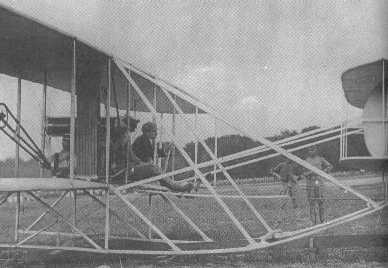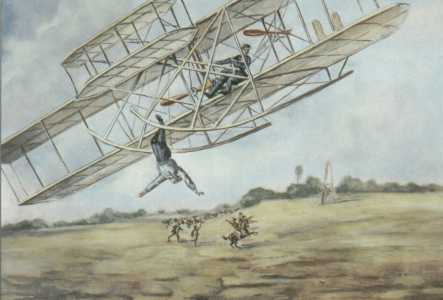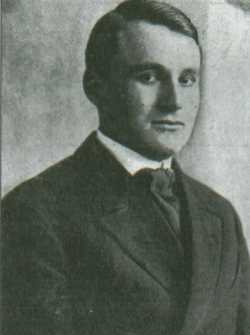|
triumph
and tragedy at Fort Myer
film downloads
Fort Myer Trial:
download
The trials began on
September 3 in an atmosphere of suspicion and acrimony.
Orville put the
Model A through its paces
and it performed beautifully, soaring, banking, and
turning sharply and
seemingly effortlessly in the air. (The
Wrights had prepared for both the U.S. and the French
exhibitions by practicing their flying at Kitty Hawk earlier
in the summer.) Orville made four flights of more than one
hour each and took up a passenger on three of the flights
(both had been conditions set forth by the government for
any plane it would consider purchasing). There was simply no
question in the Army’s mind (or in Curtiss’ or Selfridge’s)
that the Wright Model A represented the cutting edge of
flying machines.

Curtiss and the AEA testing their aircraft in Hammondsport
On September 17, Orville
planned one more test, this one with Selfridge aboard.
Hoping to impress Selfridge with additional speed (or
possibly because Selfridge himself was heftier than the
other passengers he had taken up), Orville replaced the
original propellers with longer ones. Selfridge climbed
aboard and sat in the cushioned seat (aviators did not yet
wear seatbelts) and looked forward to an exciting flight.
The airplane circled the field three times at an altitude of
about 150 feet (45.5m). On the fourth lap, one of the
propellers cracked along its length. The difference in
thrust between the two propellers created a
vibration that loosened the shaft of the
other propeller, which spun wildly and soon cut a wire
that controlled the rudder. At that point,
Orville lost control of the
plane and it headed to the ground nose first.

Fort
Myer trials on September 17, 1908.
Aboard as
passenger (to Orville’s right) is
Curtiss colleague
and AEA associate llieutenant
Thomas Selfridge. Wright
had replaced the propellers with
slightly larger ones
to accommodate Selfridge’s greater
weight. Selfridge
seems serious, even a bit grim.
The plane crashed and raised a cloud of dust that
made it difficult for the first rescuers on the
scene to find either
Orville or Selfridge. The first to spot the aviators
as the smoke cleared was
W.S. Clime, a photographer.
Orville was hanging from the plane’s mangled wires;
Selfridge had struck the
ground and lay motionless.

In representations of the accident (such
as in Gallieni’s painting)
Selfridge is often depicted falling out of the
Model A,
while in fact he stayed with the
craft and was injured,
along with Orville, in the crash.
Orville left the field conscious, recuperated in a hospital,
and returned to Dayton in a wheelchair six weeks
later. He eventually recovered and
with typical Wright grit, he
forced himself to walk without a limp, though his hip
and leg bothered him the rest
of his life. But Selfridge was
declared dead the next day and became the first
casualty of the age
of flight (and the fourth to die in pursuit of the
dream of flight). News of
both Orville’s triumph and the
tragedy of Selfridge’s death
spread throughout the world and moved
even the most intrepid flyers.

Selfridge
The trials
were called off (mainly because of Orville’s injury), but it
was clear that the Army was going to buy the Wright planes.
When the Wrights founded their flying school in Montgomery,
Alabama, and in Pau, France, their announced reason for
doing so was to enable them to enter their own planes, flown
by their own pilots, in competitions, but in reality they
created these schools because they were aware that the
planes they would be selling to governments would require
trained pilots and instructors.
The trials
were not resumed until July 27, 1909, when Orville again put
the Model A through its paces. This time, President Taft was
among the spectators and Lieutenant Frank Lahm, Commander of
the Army Signal Corps, rode as a passenger—and neither would
have occurred had there been any doubt about the success of
the trial. The army bought one plane, but there were clear
indications that others would be ordered later. The amount
paid was thirty thousand dollars, five thousand of which was
a bonus for exceeding the speed requirements.
|
